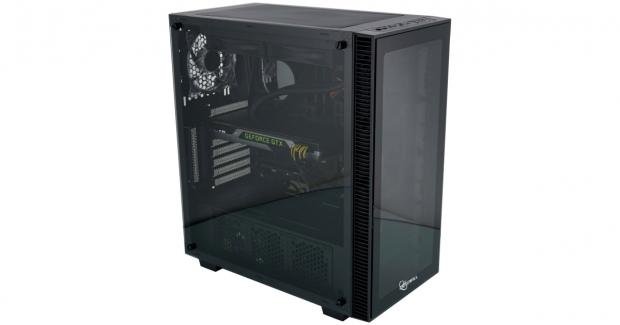
The Bottom Line
Introduction, Specifications, and Pricing
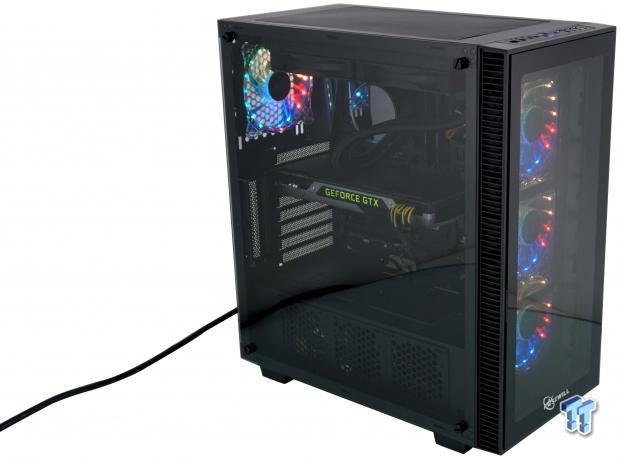
We all know that Rosewill tends to take products already on the market and readdress some of the features to deliver their take on what that product should be. Sometimes they do this very well, and there has been a time or two where their ideas have not panned out so well. On the whole, Rosewill has a fairly decent track record with this type of production, however. There have been many instances in the last few years, where Rosewill has either delivers something better than the original, and if not better, these products tend to be sold at a greater value than others on the market. In the end, most of the time, what Rosewill is doing tends to be a win for the masses of buyers out there, who are either looking for something a bit better or those who do not have pockets deep enough to buy these products from the original maker.
If you remember back to about this time last year, we ran across a chassis called the Anidees Crystal, which we believe to be the first of its kind. Even if they were not the originator of this assembly of parts and components, they were the first to send us one to bring this design to our attention. At that time, we found this chassis to be a top of the line submission and awarded it highly, but since then, we have seen this chassis in some form or another, too many times to count now. Whether it was AeroCool that followed them, or Raidmax, or even other Rosewill cases, one thing is for sure, the basic form of this chassis has become very popular among many manufacturers. What then is left for Rosewill to do after the Rosewill Meteor XR was not such a huge hit with us? Well, you can follow the originator to a further extent as not to cut off the airflow, yet at the same time, deliver a chassis which is more impressive than the original form of the chassis we loved so much.
The latter is exactly what Rosewill is up to with the chassis we are looking at today. We are bringing forth the Rosewill Cullinan MX Mid-Tower Chassis, which follows very closely to the Crystal chassis but has bested that case in a few ways in which we did not see coming. Instead of a set of four LED fans, Rosewill has opted for four RGB fans with a remote control. Beyond that, there are inclusions to the interior which offer more storage options and also more cooling options. Lastly, rather than running head to head with the Crystal, Rosewill has decided to lower the price as well. So not only is it improved well beyond the first of its kind that we saw, but it is also more affordable, which will make anyone's bank account happier too.
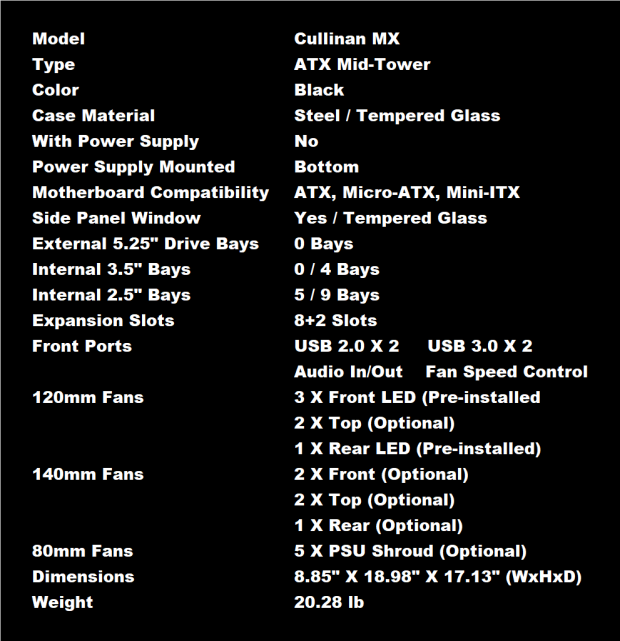
The Cullinan MX is a mid-tower chassis which is made of steel and plastic, while also sporting three sides covered in tempered glass. To give this chassis a sleek look, not only is the inside and outside painted black but when it came to choosing the tempered glass, Rosewill went with clear glass to deliver the look of a glass obelisk when the chassis just sits there but also allows for an unimpeded view inside. Also on the exterior of the chassis is the front I/O panel, found at the top of the chassis, which includes all of the bits we are used to in cases, but also adds a three-position fan switch. Also, part of the exterior is the expansion card slots, and what we find there is a departure from many if not most of the mid-tower offerings today. Rosewill not only went with eight slots running horizontally rather than the typical seven, but they also add in two vertical slots so that one may show the bottom of the video card to the tempered glass panel.
Inside of the Cullinan MX, we find not a single optical drive bay. However, when it comes to storage, this chassis has many options. 3.5" drives can be placed in up to four locations, and all of these locations are also removable and is why there is also the notation of zero locations. When it comes to 2.5" drives, there is the pair of HDD cage trays which will house them; there are two trays hidden behind the motherboard tray, there is a pair of locations on top of the PSU cover, and three more options on the side of it as well. As for motherboard compatibility, there is room for Mini-ITX, Micro-ATX, or ATX motherboards, but due to the way the motherboard tray is formed, you may not squeeze in anything larger.
Cooling is handled well in the Cullinan MX. Out of the box, the front of the chassis is filled with three 120mm fans, as well as a fourth 120mm fan at the back. All of these fans are RGB LED capable, but the choices of colors are made with a remote control rather than having to cycle a button or flip switches on a fan hub. Beyond what comes in the chassis, there is the ability to use a pair of 140mm fans in the front, and the top of the case will house a pair of either 120mm or 140mm fans. The back of the chassis also has the option to swap to a 140mm fan, but that is not where the options stop. With the layout of the new PSU cover inside of the Cullinan MX, there are five locations to add fans, but any fans added to it must be 80mm in size.
If what we have discussed is not enough to wet your whistle, there is one other factor that may still sway your decision-making process. While the Cullinan MX is very similar to the Crystal, Rosewill has upped the game with many more options to be had. On top of that, Rosewill also thought that the $149.99 price of the Crystal was too much. So, in the Cullinan MX, not only do you get much cooler fans to look at under the tempered glass, you get many more storage locations, a remote control, a fan speed adjustment switch, and all of it comes at just $129.99. That being said, even though many may be tiring of the internal design of all of these similar cases, it appears Rosewill hit the nail on the head and is now offering the best of the bunch.
Chad's Chassis Test System Specifications
- Motherboard: ASUS Maximus IX Code Z270 (buy from Amazon)
- CPU: Intel Core i7 7700K (buy from Amazon)
- Cooler: NZXT Kraken X62 (buy from Amazon)
- Memory: Team T-Force Night Hawk RGB TF1D48G3000HC16CBK
- Video Card: NVIDIA GeForce GTX 980 (buy from Amazon)
- Storage: Samsung XP941 256GB (buy from Amazon)
- Power Supply: SilverStone SST-ST85F-G (buy from Amazon)
- OS: Microsoft Windows 10 Home 64-bit (buy from Amazon)
Packaging
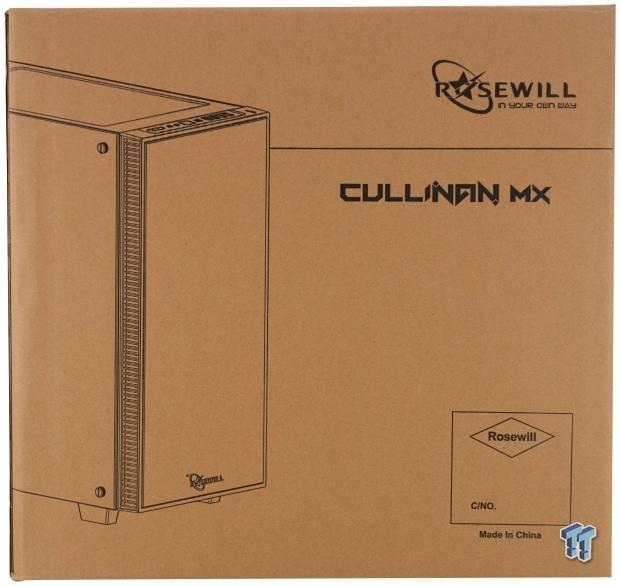
The packaging is kept as basic as possible, which leaves the vast majority of the money spent to be used on the chassis. Plain cardboard is used to box the chassis, and the information is delivered from the black ink used in a silk screening process. On the front of the box, we see the outline of the chassis to the left, with the Rosewill name, logo, and chassis name presented on the right side.
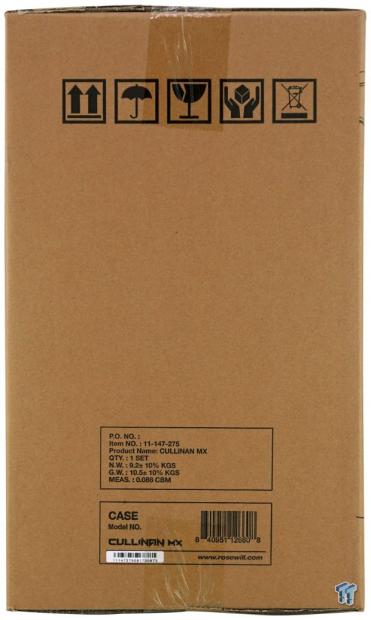
The top of this side panel offers five icons which are used to show which end is up, that it should not be allowed to get wet, that it is fragile, that it should be handled with care, and it is something which can be recycled versus throwing into the trash. Other than that, there is a box at the bottom which shows the name of the chassis, along with the weight with and without the packaging.

The back of the box is identical in every way to what we saw on the front panel. Doing this is boring to look at and describe, but it also saves money not having to produce a different screen to use for it.

The last of the external panels are also identical to the panel on the opposing side of the box. Again, it saves time and money, which is a good thing for the customer.
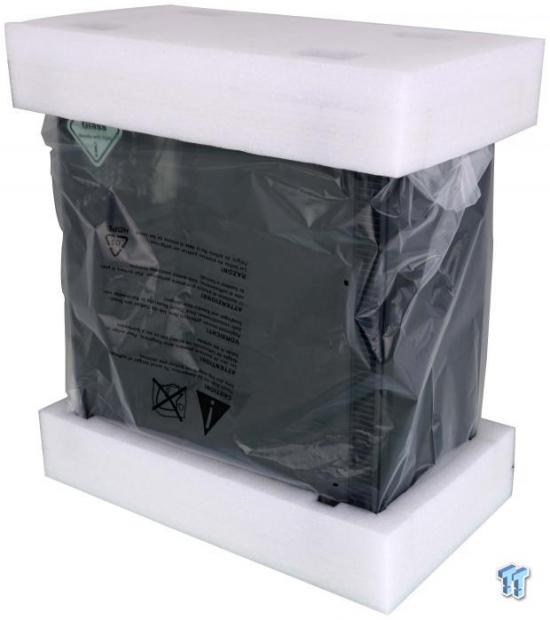
We did not find plastic clinging to any of the tempered glass panels under the plastic liner which surrounds the chassis, and we also see Rosewill opts for dense foam over Styrofoam due to the weight. What we can say, is that even without the extra plastic, and using better end caps, our Cullinan MX showed up in pristine condition for usage and its photography session.
Rosewill Cullinan MX Mid-Tower Chassis
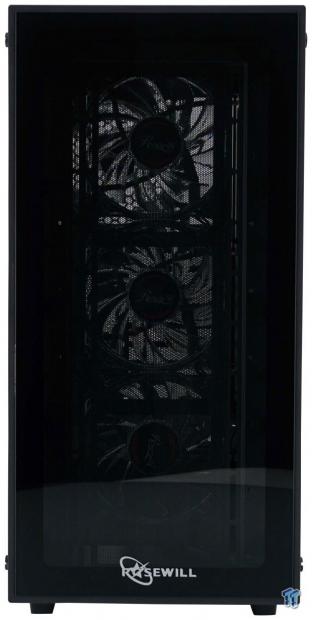
The front of the Cullinan MX is sleek and simplistic in design. A super thin bezel of black plastic surrounds the edges of the tempered glass, which offers a bit of a view of the interior, and also has the Rosewill name and logo painted in white at the bottom.
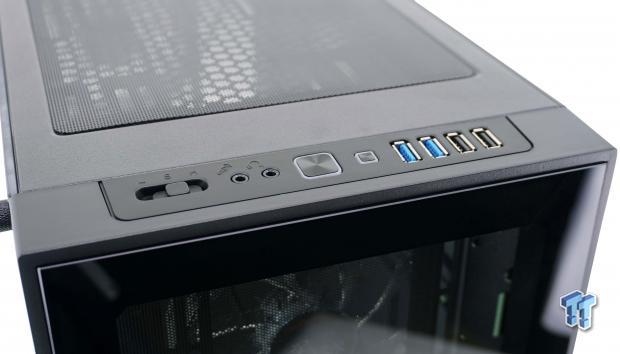
The front I/O panel is attached to the chassis, and the front bezel has been cut to go around it. On the left, we see the three-position fan controller and the pair of HD Audio jacks. In the center is the larger power button with a blue LED ring around it showing chassis power, while the smaller reset button is to the right with its red LED ring for HDD activity. At the right, we then locate a pair of USB 3.0 ports with a pair of USB 2.0 ports at the end.
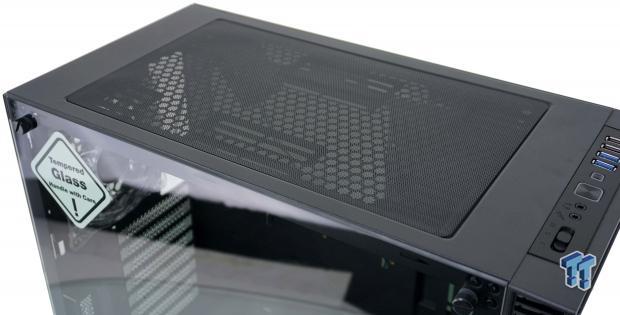
The top of the chassis has thick steel sections at the front and back, with thin sides, all surrounding the fine mesh dust cover. The dust cover is magnetically applied and makes adding fans or AIOs very simple to accomplish.
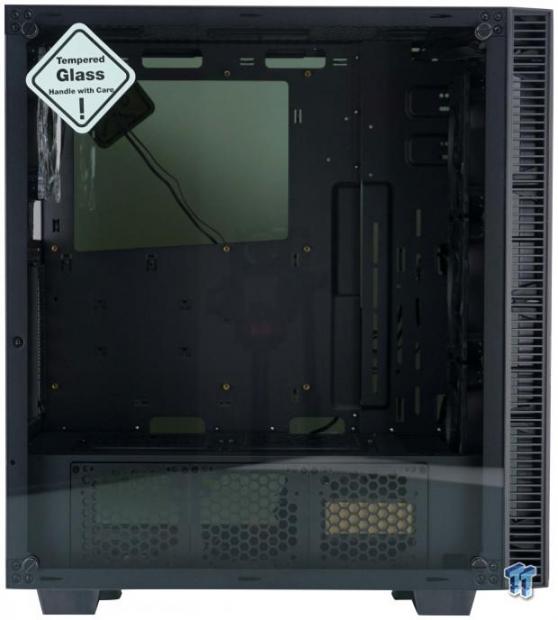
The left side of the chassis is completely covered with tempered glass, is screwed onto the chassis at the four corners, but unlike the front panel, there is no black paint blocking the view of the chassis frame. We can also see that the bulk of the front bezel is opened up to allow as much air into the front of the chassis as possible.
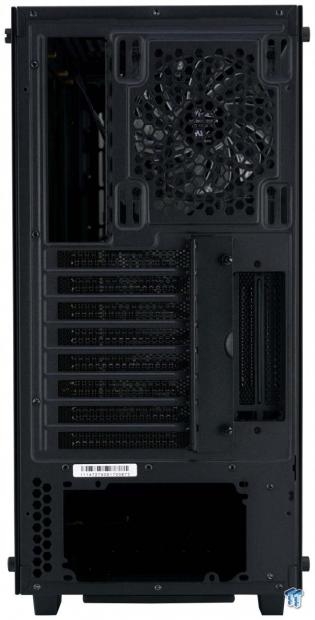
At the back of the Cullinan MX, we find that fan and the rear I/O set high in the chassis, which does not leave much room for extra cooling options at the top, but then we move down and see ten expansion slots in this mid-tower. The bottom of the chassis is where the PSU is to be placed, and we can see just a bit of the dust filter under it.
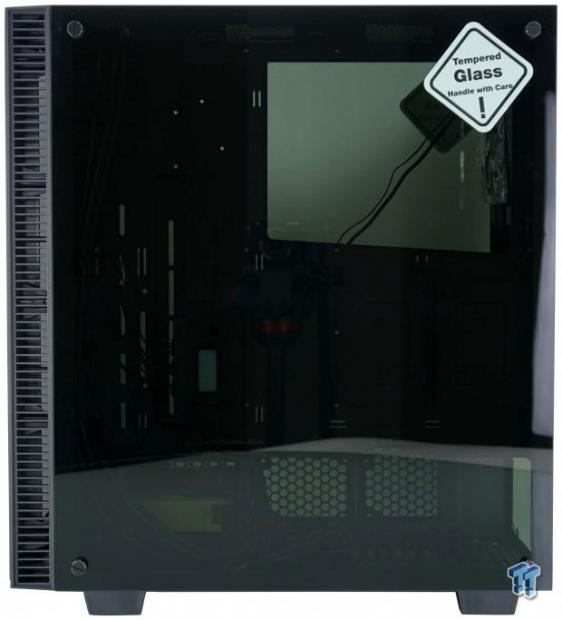
The right side of the chassis mimics what we saw on the left, down to every detail. The only thing which changes besides the way the case is facing is that you can see the back of the motherboard tray. It allows users to show off the fan hub, 2.5" drives, and also their wire management skills.
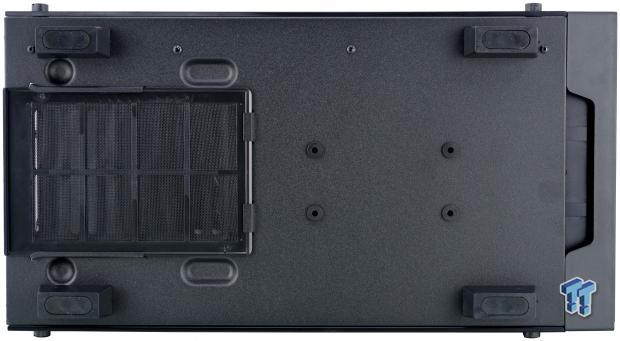
Supporting the chassis are chunky rectangular feet with long oval rubber pads on them to give some grip and stability. On either side of the dust filter, we see the bumps in the steel which support the PSU on the inside, but in front of it all, we also find grommets which allow a 3.5" drive to mount to the floor of the Cullinan MX.
Inside the Cullinan MX
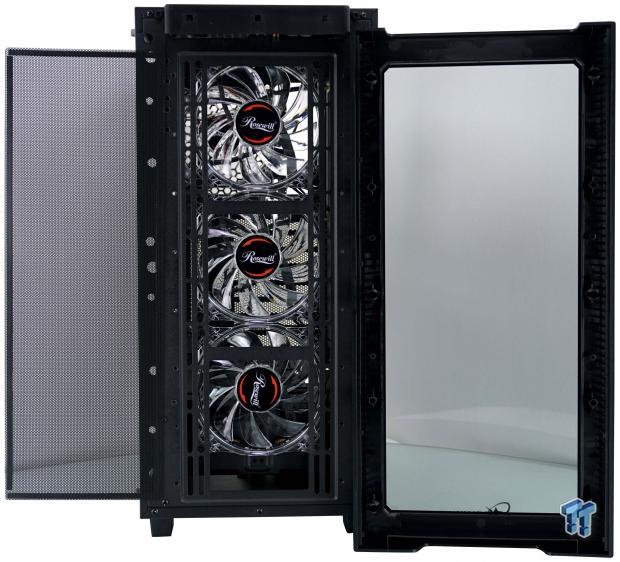
Pulling the bezel off and exposing the front of the chassis, we have much to discuss. No wires are connected to the bezel, which is great. The front of the chassis uses a magnetically attached dust filter, which makes cleaning a breeze. We also see the fans supplied in the chassis along with the slots on either side of it to allow 140mm fans and at various locations for both fan sizes.
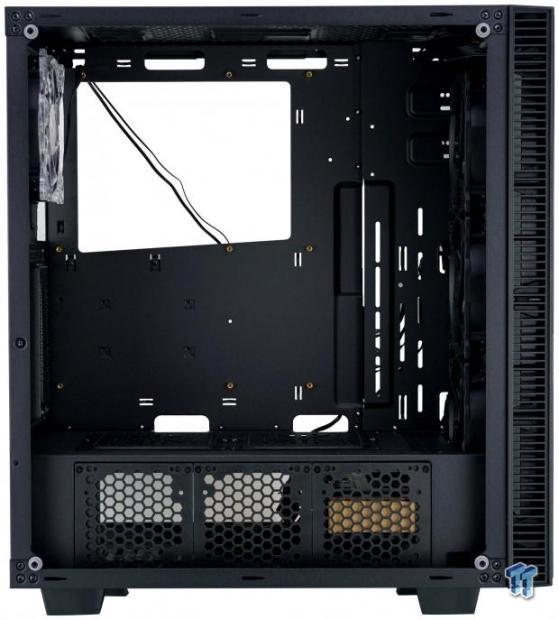
Initial impressions of the vast open cavity are nice, and this may spark a moment of déjà vu too. However, many times we have seen that motherboard tray is inconsequential at this point, as we would like to direct your attention to how unique that PSU cover is.
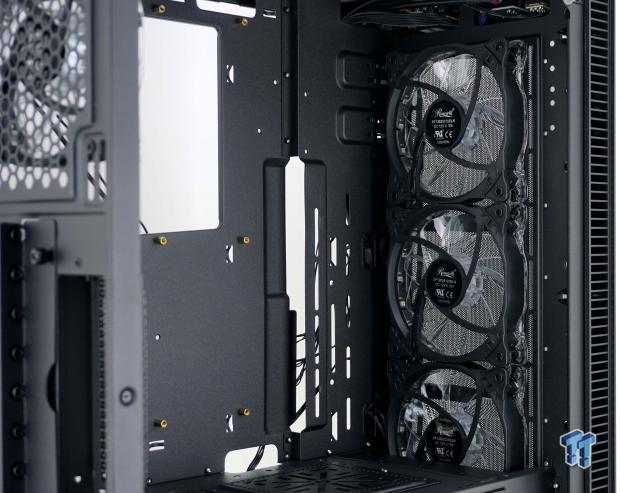
Hanging inside of the front of the chassis is this trio of 120mm fans. Specifically, they are the Rosewill DF1202512SELN fans which are made of black frames and clear blades, and are also RGB LED illuminated around the edge of the frames.
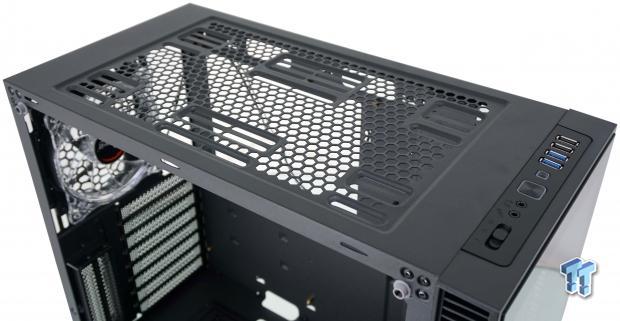
The honeycomb mesh is wide open for good airflow out the top of the chassis, and without pets or children, it may be best to remove the dust filter to get the best potential. The top will also house 120mm or 140mm fans, and they can be placed towards the left of the chassis, or set back a bit further to the right side of the case too.
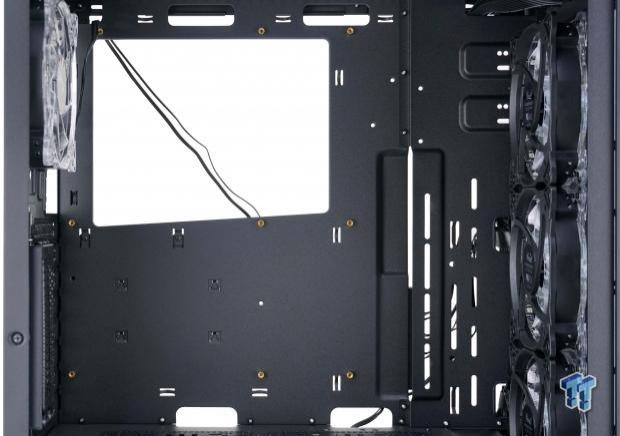
No matter how many times we have shown you a similar image to this, we will admit that the design is fair for the market. The CPU cooler access hole is large and can be used for wire managing Mini-ITX motherboards. There are six holes to pass wires through, although none of them have grommets, and many places to tie up wires too.
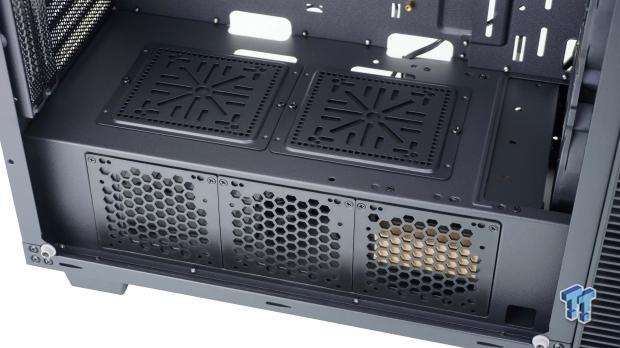
The PSU cover is something we have not seen so far. The front of the cover has a removable panel for AIO installations, and we can see the screws which allow the HDD cage to be removed. The pair of plates on top of the cover can be used for 80mm fans, or 3.5" HDDs, or 2.5" drives, and can even be used to support pumps and reservoirs. The vertical bit of the cover has three panels, which can be used for 80mm fans or you can attach 2.5" drives to it, but all wires need to go to the right to get behind the cover.
Inside the Cullinan MX Continued
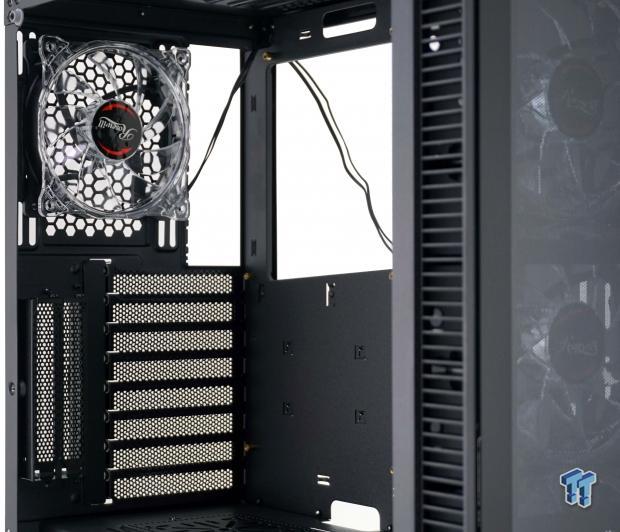
The rear of the chassis is currently supporting a fourth 120mm RGB fan, and it is pre-wired to the fan hub. Below the fan, we see the ten slots, but to access the vertical slots, you will have to remove the fan to get the screwdriver in line with the screws. As for the horizontal slots, they are accessed outside of the case.
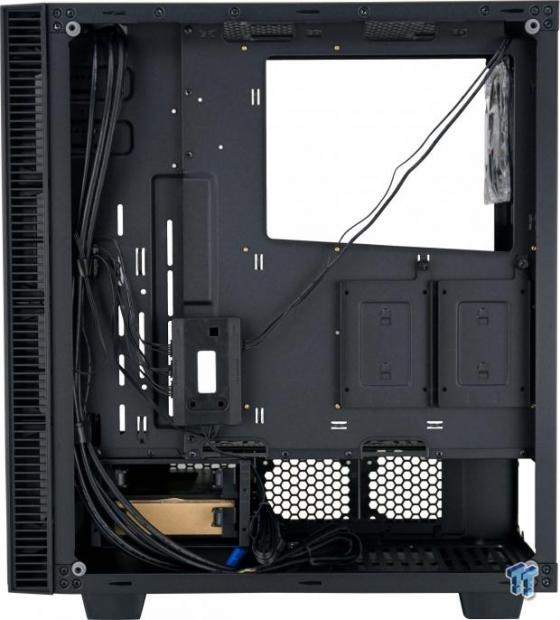
Behind the motherboard tray, we see a lot going on. The front I/O wiring is run through Velcro straps before it leads to the bottom of the case, where we see the box of hardware. The left side of the chassis offers 30mm of room, while the larger section to the right is cut to only 20mm of space.

The large box seen at the left side of the motherboard tray is the fan hub. On the left, we see that the fans are connected with 5-pin connections, not typical to any other fan, but you can install up to eight of these fans to this hub. If for some reason you do not want to use the remote, you do have pad switches which will change the color or mode that the fans RGB LEDs display.
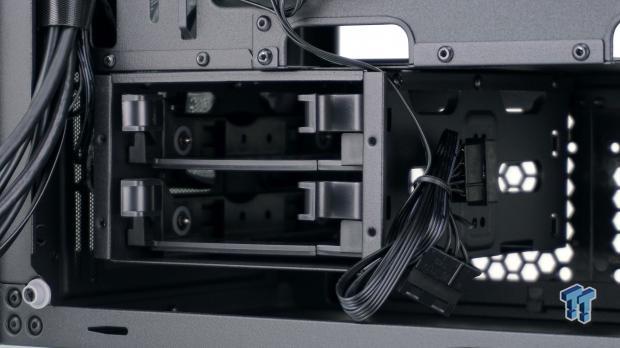
Hanging from under the PSU cover, at the front of the Cullinan MX, we have the HDD cage. Inside of the cage, there is a pair of plastic trays, and both are made to allow for 2.5" or 3.5" drives. This will need to be removed if opting for a 360mm AIO. The Molex power lead is from the fan hub, while another cable runs to the fan speed controller.

At the back of the Cullinan MX, we find plenty of room for the PSU, but we do suggest with modular PSUs, the wires are attached to the unit before installation, especially if you are keeping the HDD cage where it is.
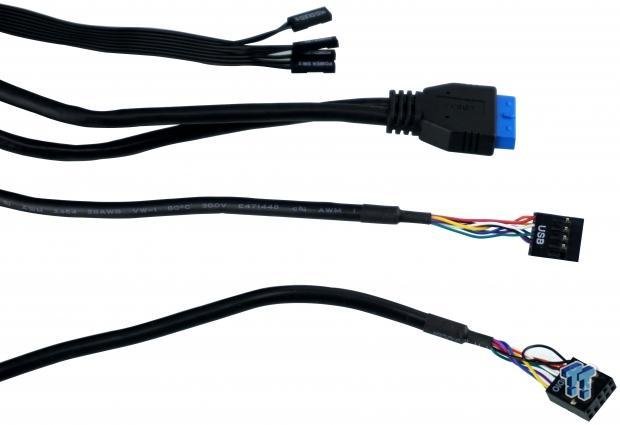
All of the cables are black for the most part, except for the ends of the first couple of cables. The HD Audio and USB 2.0 cables are what we see at the bottom. In the middle is the native USB 3.0 lead, with the button and LED leads coming out as one ribbon cable.
Hardware & Documentation
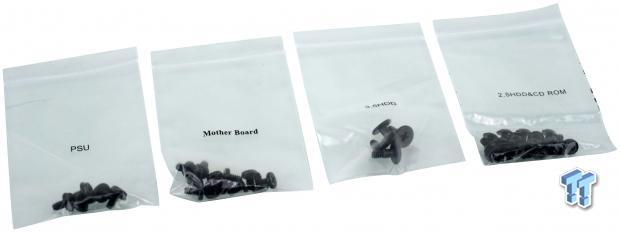
Inside of the box found in the HDD cage, we located four small bags with hardware inside of them, each of which is labeled for its intended usage. There are screws for the PSU on the left, and the 6-32 screws for the motherboard installation, next in line. We also see the four HDD screws to use on the floor of the chassis, and a bunch of M3 screws for 2.5" drive mounting.
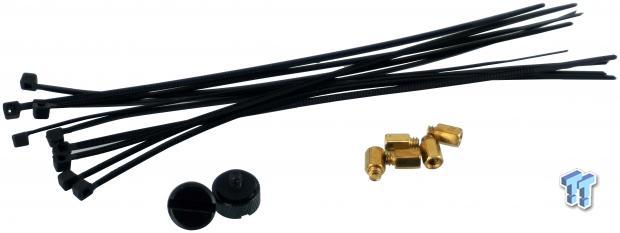
In a longer bag, we found these bits. Rosewill sent nine zip-ties to help contain the wires and is sufficient for most people's needs. We can also see that Rosewill sent an extra pair of screws for the glass panel mounting to the case, and there are five standoffs which can replace ones on the motherboard tray, or be used to replace the ones under the gray grommets, which hold the glass to the chassis.

Rather than cycle through the buttons on the fan hub, it is much easier to use the included remote control for the RGB LED lights in the fans or compatible LED strips. Lights can be turned off and on, the speed of the modes and direction can be changed, and on the left, are eight predefined color choices. The mint green buttons on the right are then used to change the rainbow, gradient, blade, or breath modes.
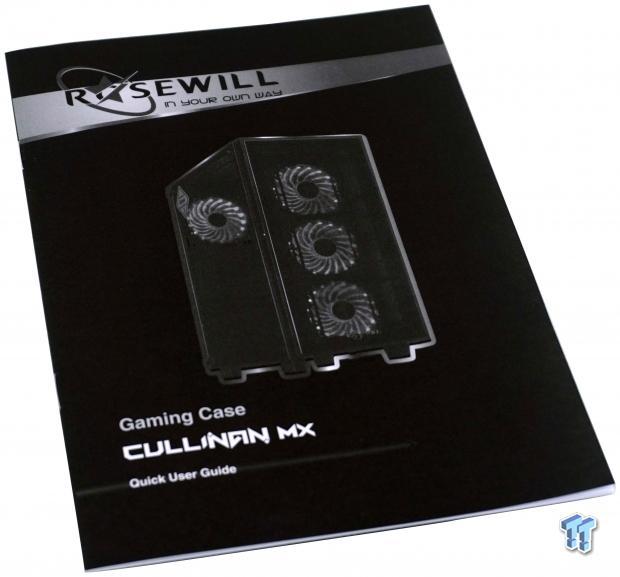
The quick user guide is more of a manual, as it is well written and full of information. Starting off with a list of all the bits you were intended to have as well as a wiring diagram, as well as thanks for buying the product is a good start. What follows are rendering with much text to help even the most novice user complete the build, and it even includes a page on how to use the remote, one for water cooling compatibility, and ends with the specifications of the Cullinan MX.
Case Build & Finished Product
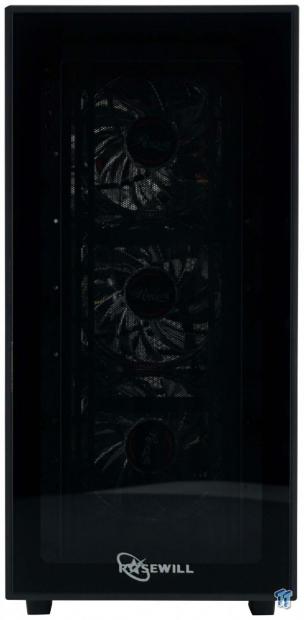
The front of the chassis does not change from start to finish with the Rosewill Cullinan MX, and we like cases such as this. Of course, if you care to change the fans, or install an AIO in the front, the view will then be different.
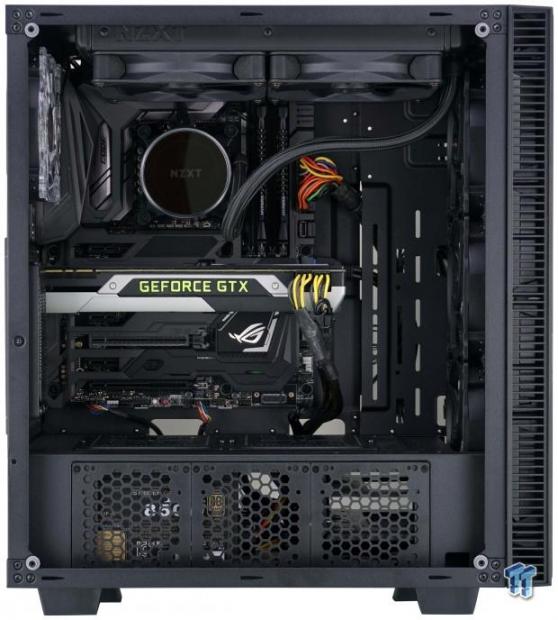
To complete the build, we did have to make concessions as to which RAM to use, as the standard RAM for this build blocked the 280mm AIO from being installed at the top. As for the motherboard, we found no issues installing it, but do mind the rear fan wiring when putting the motherboard in. The video card is level with the world, and most of the wires are well hidden from view.
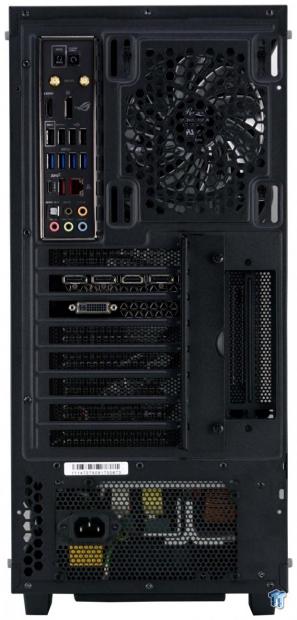
The rear I/O dust shield only locks in at the top and the bottom, and while the GPU can be mounted, we did have to force the back of the case inward to align the screws to the slots. As for the PSU at the bottom, it does go into place and mounts easily, but we would have liked rubber pads for its support rather than steel bumps in the floor of the chassis.
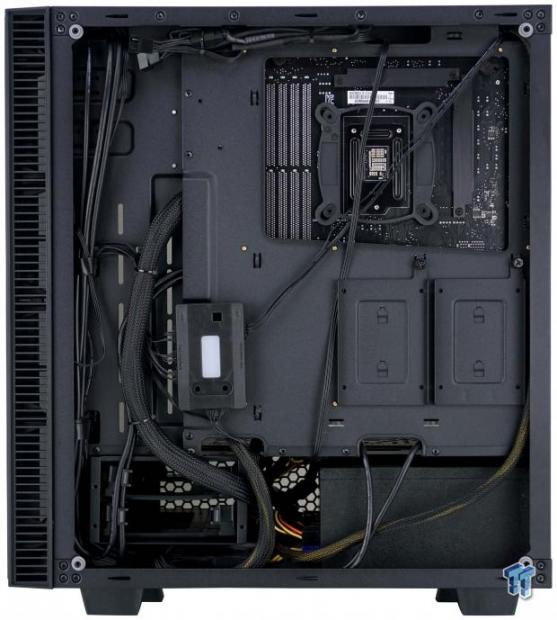
We did not try that hard to do much with the wiring here. The 8-pin lead will hide within the frame at the back, and the 24-pin ran to its needed location and was tied to the motherboard tray. Most of the rest of the wires go where they need to be, and either hide at the bottom of the chassis behind the frame, or in front of the PSU.
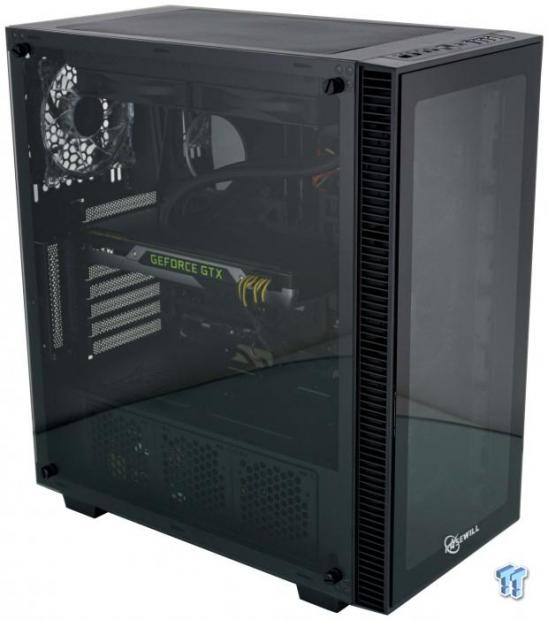
While we do wish that the side panel's glass was painted like that on the front bezel, we won't be pulling too many points for the lack of it. It is because the overall look is still decent enough to make many look past that. We love the view inside of the chassis, and even though we see many mid-towers with glass on them, we are still a sucker for this aesthetic choice.
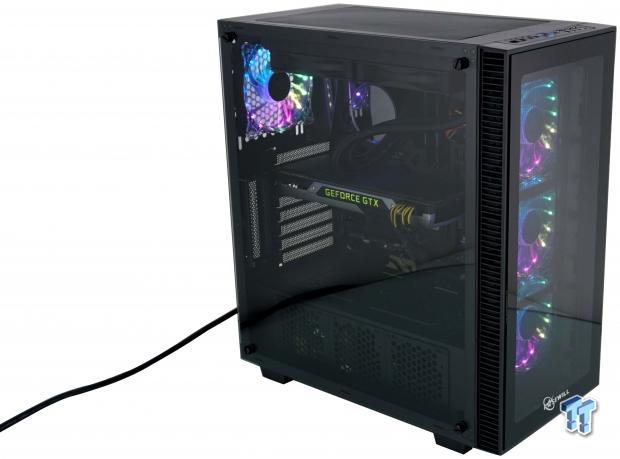
Where the Rosewill Cullinan MX shines is when the chassis is up and running. Yes, the added interior features and modularity are all great, but the rainbow mode running on the fans takes the Cullinan MX to the top of the heap with this chassis design. There are many ways to go with the lighting, but we felt the rainbow mode shows not only the intensity but the possibility of RGB LED colors used in other modes as well.
Final Thoughts
While we were not especially fond of what Rosewill presented with the Meteor chassis which uses a similar interior, that is all behind us now, and we cannot fault this design in any of the same ways. The ventilation at the front of the Cullinan MX is wide open to draw in whatever airflow is needed from the fans behind the glass. Since there is no HDI cable or port for VR, we cannot complain about the way in which it exits the chassis and has to be run, and with all the extra bits that are included in the Cullinan MX, we are looking at a far superior offering now. The Cullinan MX is sleek, attractive, full of life with RGB LED fans and full of reasons to look at this as your next mid-tower solution.
There is a three-stage fan controller, and even set at maximum speed, the chassis is nearly inaudible, and from a foot away the meter was reading only 29 dB. While many may never opt to add 80mm fans, they can provide more airflow under the PSU cover, or be used to inject air into the bottom of horizontally mounted video cards. If extra fans are not on the list of things to do, how about using the five locations for SSDs, 2.5" HDDs, or on top of the PSU cover, option to try to install a pump or reservoir there. We were even able to use a 240mm AIO mounted in the top of the case even without a bunch of room above the motherboard. The chassis is modular in that you can remove the HDD cage or the cover in the PSU shroud which allows for a thin 360mm radiator and fans to go inside of the front. Yes, there is a view of the back of the motherboard through the tempered glass, but with it being as dark in there with black steel and black cables, only bright stickers on drives or the PSU will stand out and be visible. For us, going from what we had last from Rosewill to the Cullinan MX, it is like a complete one-eighty, all build from the same basic components.
We were huge fans of the Anidees Crystal when it came out, and this whole rush of cases with similar interiors began. Along the way, there were some winners, and those that got participation trophies, but now getting our hands-on the Cullinan MX, we may have just seen the best of the bunch. Pricing varies wildly depending on what features and additional bits you want with the chassis, but what we love is that Rosewill is trying to not only deliver the best version of this chassis, they did so saving money as well.
At just $129.99, we have seen the best, well rounded; the most feature-rich version of this chassis to hit the market. We can only imagine we will see similar cases like this again, but to date, our money is on Rosewill and the Cullinan MX, as it is the best bang for the buck option so far.
Chad's Chassis Test System Specifications
- Motherboard: ASUS Maximus IX Code Z270 (buy from Amazon)
- CPU: Intel Core i7 7700K (buy from Amazon)
- Cooler: NZXT Kraken X62 (buy from Amazon)
- Memory: Team T-Force Night Hawk RGB TF1D48G3000HC16CBK
- Video Card: NVIDIA GeForce GTX 980 (buy from Amazon)
- Storage: Samsung XP941 256GB (buy from Amazon)
- Power Supply: SilverStone SST-ST85F-G (buy from Amazon)
- OS: Microsoft Windows 10 Home 64-bit (buy from Amazon)

